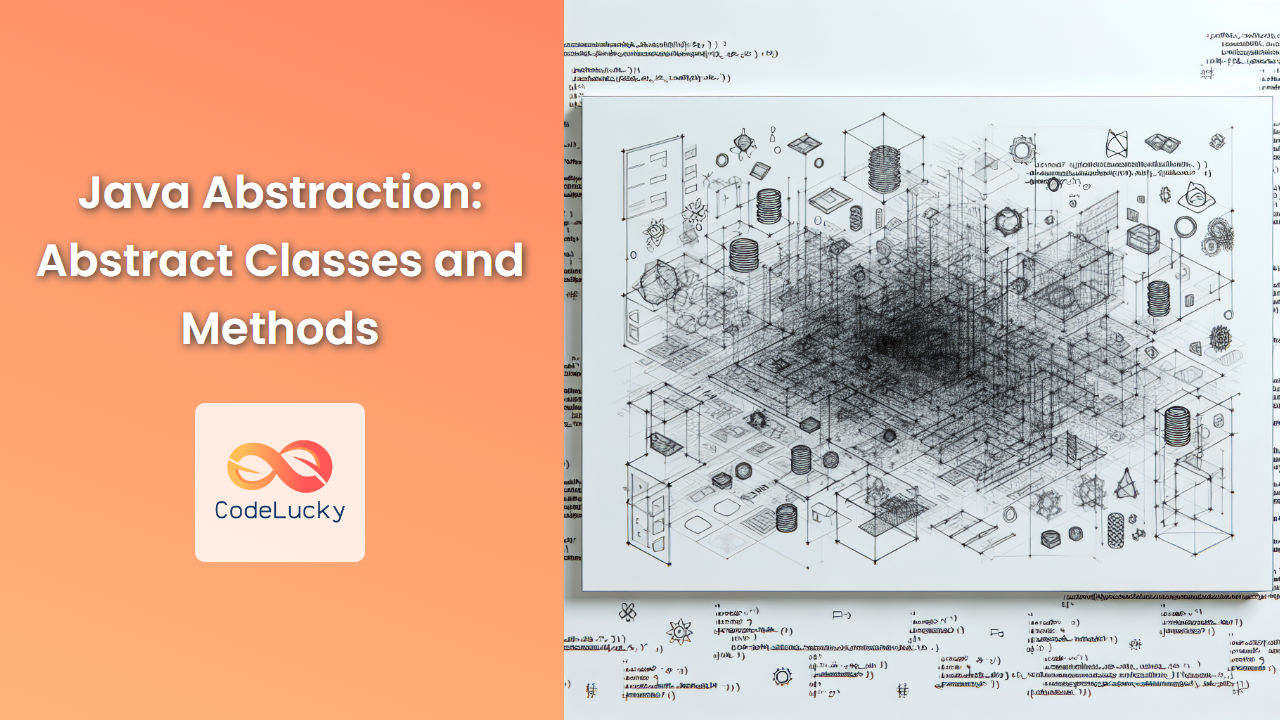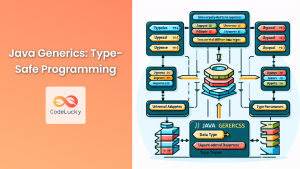Java abstraction is a fundamental concept in object-oriented programming that allows developers to hide complex implementation details and expose only the essential features of an object. This powerful technique enhances code reusability, reduces complexity, and promotes a cleaner, more maintainable codebase. In this comprehensive guide, we'll dive deep into Java abstraction, focusing on abstract classes and methods.
Understanding Abstraction in Java
Abstraction in Java is the process of hiding the internal details of an application from the outside world while highlighting only the functionality. It's like driving a car – you don't need to know how the engine works internally to operate the vehicle. You just need to know how to use the steering wheel, pedals, and other controls.
In Java, abstraction is primarily achieved through two mechanisms:
- Abstract classes
- Interfaces
Today, we'll focus on abstract classes and methods, which form the backbone of Java abstraction.
Abstract Classes in Java
An abstract class in Java is a class that cannot be instantiated directly. It serves as a blueprint for other classes and may contain both abstract and non-abstract (concrete) methods. Abstract classes are declared using the abstract keyword.
Here's the basic syntax for declaring an abstract class:
abstract class AbstractClassName {
// Abstract and non-abstract methods
}
Let's look at a practical example to understand abstract classes better:
abstract class Shape {
protected String color;
public Shape(String color) {
this.color = color;
}
// Abstract method
public abstract double calculateArea();
// Concrete method
public void displayColor() {
System.out.println("The shape color is: " + color);
}
}
In this example, Shape is an abstract class that defines a common structure for all shapes. It has:
- A protected field
color - A constructor to initialize the color
- An abstract method
calculateArea()that must be implemented by subclasses - A concrete method
displayColor()that is already implemented
🔑 Key points about abstract classes:
- They cannot be instantiated directly
- They may contain abstract and non-abstract methods
- They can have constructors and static methods
- They can have final methods which will prevent the subclass from changing the body of the method
Abstract Methods in Java
An abstract method is a method that is declared without an implementation. It only has a method signature and no method body. Abstract methods must be implemented by the first concrete (non-abstract) subclass.
Here's the basic syntax for declaring an abstract method:
abstract returnType methodName(parameters);
Let's extend our Shape example to see how abstract methods work in practice:
class Circle extends Shape {
private double radius;
public Circle(String color, double radius) {
super(color);
this.radius = radius;
}
@Override
public double calculateArea() {
return Math.PI * radius * radius;
}
}
class Rectangle extends Shape {
private double length;
private double width;
public Rectangle(String color, double length, double width) {
super(color);
this.length = length;
this.width = width;
}
@Override
public double calculateArea() {
return length * width;
}
}
In this example:
CircleandRectangleare concrete classes that extend the abstractShapeclass- Both classes provide their own implementation of the
calculateArea()method - The
displayColor()method is inherited from theShapeclass
🔍 Note: Any class that extends an abstract class must implement all of its abstract methods, or it must also be declared abstract.
Benefits of Using Abstract Classes and Methods
Abstraction through abstract classes and methods offers several advantages:
-
Code Reusability: Abstract classes can be used as a base for multiple related classes, promoting code reuse.
-
Flexibility: You can define a common interface for a set of subclasses, allowing you to use them interchangeably.
-
Security: By hiding certain details and only showing the important details of an object, abstraction enhances application security.
-
Reduced Complexity: Abstraction helps in reducing programming complexity and effort.
Let's see these benefits in action with an extended example:
abstract class Vehicle {
protected String brand;
protected String model;
public Vehicle(String brand, String model) {
this.brand = brand;
this.model = model;
}
public abstract void start();
public abstract void stop();
public void displayInfo() {
System.out.println("Brand: " + brand + ", Model: " + model);
}
}
class Car extends Vehicle {
public Car(String brand, String model) {
super(brand, model);
}
@Override
public void start() {
System.out.println("Car engine starting...");
}
@Override
public void stop() {
System.out.println("Car engine stopping...");
}
}
class Motorcycle extends Vehicle {
public Motorcycle(String brand, String model) {
super(brand, model);
}
@Override
public void start() {
System.out.println("Motorcycle engine starting...");
}
@Override
public void stop() {
System.out.println("Motorcycle engine stopping...");
}
}
public class VehicleTest {
public static void main(String[] args) {
Vehicle car = new Car("Toyota", "Camry");
Vehicle motorcycle = new Motorcycle("Harley-Davidson", "Street 750");
car.displayInfo();
car.start();
car.stop();
System.out.println();
motorcycle.displayInfo();
motorcycle.start();
motorcycle.stop();
}
}
Output:
Brand: Toyota, Model: Camry
Car engine starting...
Car engine stopping...
Brand: Harley-Davidson, Model: Street 750
Motorcycle engine starting...
Motorcycle engine stopping...
In this example:
- The
Vehicleabstract class provides a common structure for all vehicles CarandMotorcycleclasses extendVehicleand provide their own implementations ofstart()andstop()- The
displayInfo()method is inherited and used as-is by both subclasses - In the
main()method, we can treat bothCarandMotorcycleobjects asVehicleobjects, demonstrating polymorphism
🚀 This abstraction allows us to work with different types of vehicles in a uniform way, while still allowing for specific implementations where needed.
When to Use Abstract Classes
Abstract classes are ideal in the following scenarios:
- When you want to share code among several closely related classes
- When you expect classes that extend your abstract class to have many common methods or fields
- When you want to declare non-static or non-final fields
- When you need to provide a common, implemented functionality across all implementations of your component
💡 Pro Tip: If you're unsure whether to use an abstract class or an interface, consider this rule of thumb: Use abstract classes to define a template for a group of subclasses, and use interfaces to define a contract for what a class can do.
Limitations of Abstract Classes
While abstract classes are powerful, they do have some limitations:
-
Single Inheritance: Java doesn't support multiple inheritance with classes. A class can extend only one abstract class.
-
Tight Coupling: Abstract classes can lead to tighter coupling between the base and derived classes.
-
Less Flexibility: Once an abstract class is created, it's harder to change its design without affecting all its subclasses.
Best Practices for Using Abstract Classes and Methods
To make the most of Java abstraction, consider these best practices:
-
Keep It Simple: Don't try to model your entire system with a single abstract class. Break it down into logical, manageable pieces.
-
Use Meaningful Names: Choose clear, descriptive names for your abstract classes and methods that reflect their purpose.
-
Avoid Over-Abstraction: While abstraction is powerful, too much of it can make your code hard to understand and maintain.
-
Document Your Code: Provide clear documentation for your abstract classes and methods, explaining their purpose and expected behavior.
-
Consider Using Interfaces: For pure abstract behavior with no state, consider using interfaces instead of abstract classes.
Here's an example demonstrating these best practices:
/**
* Represents a generic database connection.
* This abstract class provides a template for different types of database connections.
*/
abstract class DatabaseConnection {
protected String url;
protected String username;
protected String password;
/**
* Constructs a DatabaseConnection with the given credentials.
*
* @param url The database URL
* @param username The username for the database
* @param password The password for the database
*/
public DatabaseConnection(String url, String username, String password) {
this.url = url;
this.username = username;
this.password = password;
}
/**
* Establishes a connection to the database.
* This method must be implemented by subclasses to provide
* database-specific connection logic.
*
* @return true if the connection is successful, false otherwise
*/
public abstract boolean connect();
/**
* Closes the database connection.
* This method must be implemented by subclasses to provide
* database-specific disconnection logic.
*/
public abstract void disconnect();
/**
* Executes a query on the database.
* This is a common operation for all database types, so it's implemented here.
*
* @param query The SQL query to execute
*/
public void executeQuery(String query) {
if (connect()) {
System.out.println("Executing query: " + query);
// Query execution logic would go here
disconnect();
} else {
System.out.println("Failed to connect to the database.");
}
}
}
class MySQLConnection extends DatabaseConnection {
public MySQLConnection(String url, String username, String password) {
super(url, username, password);
}
@Override
public boolean connect() {
System.out.println("Connecting to MySQL database...");
// MySQL-specific connection logic would go here
return true;
}
@Override
public void disconnect() {
System.out.println("Disconnecting from MySQL database...");
// MySQL-specific disconnection logic would go here
}
}
class PostgreSQLConnection extends DatabaseConnection {
public PostgreSQLConnection(String url, String username, String password) {
super(url, username, password);
}
@Override
public boolean connect() {
System.out.println("Connecting to PostgreSQL database...");
// PostgreSQL-specific connection logic would go here
return true;
}
@Override
public void disconnect() {
System.out.println("Disconnecting from PostgreSQL database...");
// PostgreSQL-specific disconnection logic would go here
}
}
public class DatabaseTest {
public static void main(String[] args) {
DatabaseConnection mysqlDb = new MySQLConnection("mysql://localhost:3306/mydb", "user", "password");
DatabaseConnection postgresDb = new PostgreSQLConnection("postgresql://localhost:5432/mydb", "user", "password");
mysqlDb.executeQuery("SELECT * FROM users");
System.out.println();
postgresDb.executeQuery("SELECT * FROM products");
}
}
Output:
Connecting to MySQL database...
Executing query: SELECT * FROM users
Disconnecting from MySQL database...
Connecting to PostgreSQL database...
Executing query: SELECT * FROM products
Disconnecting from PostgreSQL database...
This example demonstrates:
- Clear, meaningful names for the abstract class and its methods
- Proper documentation using Javadoc comments
- A balance between abstraction (in the
DatabaseConnectionclass) and concrete implementation (in theMySQLConnectionandPostgreSQLConnectionclasses) - The use of abstraction to handle different types of databases in a uniform way
Conclusion
Java abstraction, particularly through abstract classes and methods, is a powerful tool in the object-oriented programmer's toolkit. It allows you to create flexible, maintainable, and reusable code by hiding complex implementation details and exposing only the essential features of an object.
By mastering abstract classes and methods, you can:
- Create more organized and structured code
- Improve code reusability
- Enhance the flexibility and extensibility of your applications
- Implement polymorphism effectively
Remember, while abstraction is powerful, it's important to use it judiciously. Over-abstraction can lead to unnecessarily complex code. Always strive for a balance between abstraction and concrete implementation, guided by the specific needs of your project.
As you continue your journey in Java programming, keep exploring and practicing with abstract classes and methods. They are key to writing robust, scalable, and maintainable Java applications.
Happy coding! 🖥️👨💻👩💻



















